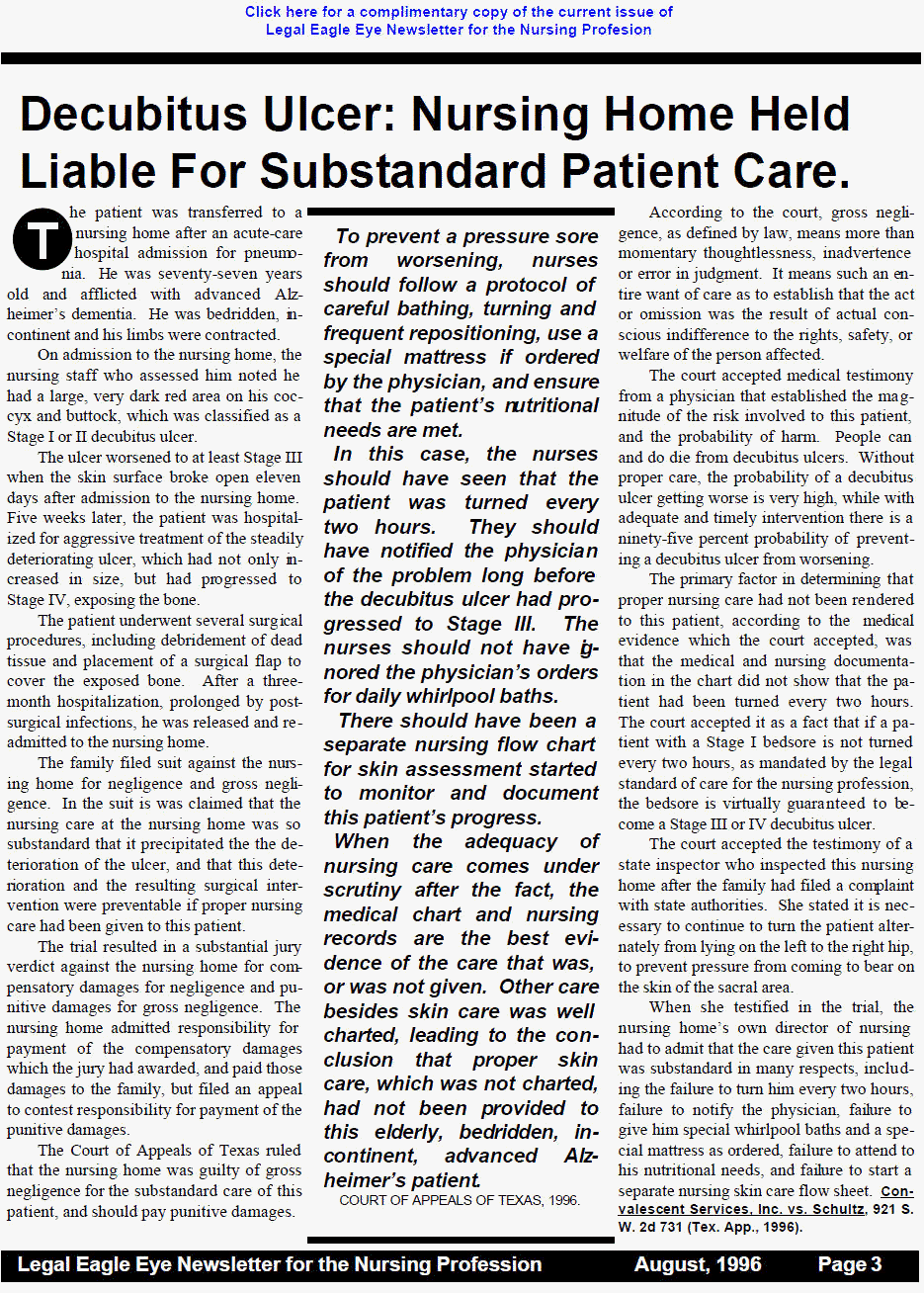
Quick Summary: When the adequacy of nursing care comes under scrutiny after the fact, the medical chart and nursing records are the best evidence of the care that was, or was not given. Other care besides skin care was well charted, leading to the conclusion that proper and adequate skin care, which was not charted, had not been provided to this elderly, bedridden, incontinent, advanced Alzheimer’s patient.
To prevent a pressure sore from worsening, nurses should follow a protocol of careful bathing, turning and frequent repositioning, use a special mattress if ordered by the physician, and ensure that the patient’s nutritional needs are met.
In this case, the nurses should have seen that the patient was turned every two hours. They should have notified the physician of the problem long before the decubitus ulcer had progressed to Stage III. The nurses should not have ignored the physician’s orders for special daily whirlpool baths.
There should have been a separate nursing flow chart for skin assessment started to monitor and document this patient’s progress. COURT OF APPEALS OF TEXAS, 1996.
The patient was transferred to a nursing home after an acute-care hospital admission for pneumonia. At the time, he was seventy-seven years old and afflicted with advanced Alzheimer’s dementia. He was bedridden, incontinent and his limbs were contracted.
On admission to the nursing home, the nursing staff who assessed him noted he had a large, very dark red area on his coccyx and buttock, which was classified as a Stage I or II decubitus ulcer.
The ulcer worsened to at least Stage III when the skin surface broke open eleven days after admission to the nursing home. Five weeks later, the patient was hospitalized for aggressive treatment of the steadily deteriorating ulcer, which had not only increased in size, but had progressed to Stage IV, exposing the bone.
The patient underwent several surgical procedures, including debridement of dead tissue and placement of a surgical flap to cover the exposed bone. After a three-month hospitalization, prolonged by post-surgical infections, he was released and re-admitted to the nursing home.
The family filed suit against the nursing home for negligence and gross negligence. In the suit is was claimed that the nursing care at the nursing home was so substandard that it precipitated the the deterioration of the ulcer, and that this deterioration and the resulting surgical intervention were preventable if proper nursing care had been given to this patient.
The trial resulted in a substantial jury verdict against the nursing home for compensatory damages for negligence and punitive damages for gross negligence. The nursing home admitted responsibility for payment of the compensatory damages which the jury had awarded, and paid those damages to the family, but filed an appeal to contest responsibility for payment of the punitive damages.
The Court of Appeals of Texas ruled that the nursing home was guilty of gross negligence for the substandard care of this patient, and should pay punitive damages.
According to the court, gross negligence, as defined by law, means more than momentary thoughtlessness, inadvertence or error in judgment. It means such an entire want of care as to establish that the act or omission was the result of actual conscious indifference to the rights, safety, or welfare of the person affected.
The court accepted medical testimony from a physician that established the magnitude of the risk involved to this patient, and the probability of harm. People can and do die from decubitus ulcers. Without proper care, the probability of a decubitus ulcer getting worse is very high, while with adequate and timely intervention there is a ninety-five percent probability of preventing a decubitus ulcer from worsening.
The primary factor in determining that proper nursing care had not been rendered to this patient, according to the medical evidence which the court accepted, was that the medical and nursing documentation in the chart did not show that the patient had been turned every two hours. The court accepted it as a fact that if a patient with a Stage I bedsore is not turned every two hours, as mandated by the legal standard of care for the nursing profession, the bedsore is virtually guaranteed to become a Stage III or IV decubitus ulcer.
The court accepted the testimony of a state inspector who inspected this nursing home after the family had filed a complaint with state authorities. She stated it is necessary to continue to turn the patient alternately from lying on the left to the right hip, to prevent pressure from coming to bear on the skin of the sacral area.
When she testified in the trial, the nursing home's own director of nursing had to admit that the care given this patient was substandard in many respects, including the failure to turn him every two hours, failure to notify the physician, failure to give him special whirlpool baths and a special mattress as ordered, failure to attend to his nutritional needs, and failure to start a separate nursing skin care flow sheet. Nursing Home vs. Schultz, 921 S.W. 2d 731 (Tex. App., 1996).